Low-Complexity 3D InISAR Imaging Using a Compressive Hardware Device and a Single Receiver
Abstract
:1. Introduction
2. Compressive Sensing Device
2.1. Device Description
2.2. Vector Signal Retrieval Principle
3. Geometry and Signal Model
4. 3D Target Reconstruction
4.1. Estimation of the Positions of Scattering Centers
4.2. Baselines Constraints
4.3. Image Distortion with Squint Mode
5. Simulation Results
6. Experimental Result
7. Conclusions
Author Contributions
Funding
Data Availability Statement
Conflicts of Interest
References
- Chen, V.C.; Martorella, M. Inverse Synthetic Aperture Radar Imaging: Principles, Algorithms and Applications; Institution of Engineering and Technology: Stevenage, UK, 2014. [Google Scholar]
- Pastina, D.; Spina, C. Multi-feature based automatic recognition of ship targets in ISAR. Sonar Navig. IET Radar 2009, 3, 406–423. [Google Scholar] [CrossRef]
- Leducq, P.; Ferro-Famil, L.; Pottier, E. Matching-Pursuit-Based Analysis of Moving Objects in Polarimetric SAR Images. IEEE Geosci. Remote Sens. Lett. 2008, 5, 123–127. [Google Scholar] [CrossRef]
- Hu, C.; Ferro-Famil, L.; Kuang, G. Ship discrimination using polarimetric SAR data and coherent time-frequency analysis. Remote Sens. 2013, 5, 6899–6920. [Google Scholar] [CrossRef] [Green Version]
- Martorella, M.; Stagliano, D.; Salvetti, F.; Battisti, N. 3D interferometric ISAR imaging of noncooperative targets. IEEE Trans. Aerosp. Electron. Syst. 2014, 50, 3102–3114. [Google Scholar] [CrossRef]
- Cooke, T. Scatterer labelling estimation for 3D model reconstruction from an ISAR image sequence. In Proceedings of the 2003 Proceedings of the International Conference on Radar (IEEE Cat. No.03EX695), Adelaide, Australia, 3–5 September 2003; pp. 315–320. [Google Scholar] [CrossRef]
- Cooke, T. Ship 3D model estimation from an ISAR image sequence. In Proceedings of the 2003 International Conference on Radar (IEEE Cat. No.03EX695), Adelaide, Australia, 3–5 September 2003; pp. 36–41. [Google Scholar] [CrossRef]
- Mayhan, J.; Burrows, M.; Cuomo, K.; Piou, J. High resolution 3D “snapshot” ISAR imaging and feature extraction. Aerosp. Electron. Syst. IEEE Trans. 2001, 37, 630–642. [Google Scholar] [CrossRef]
- Knaell, K.K.; Cardillo, G. Radar tomography for the generation of three-dimensional images. IEEE Proc.-Radar Sonar Navig. 1995, 142, 54–60. [Google Scholar] [CrossRef] [Green Version]
- Zhou, C.; Jiang, L.; Yang, Q.; Ren, X.; Wang, Z. High Precision Cross-Range Scaling and 3D Geometry Reconstruction of ISAR Targets Based on Geometrical Analysis. IEEE Access 2020, 8, 132415–132423. [Google Scholar] [CrossRef]
- Liu, L.; Zhou, F.; Bai, X.; Tao, M.; Zhang, Z.J. Joint Cross-Range Scaling and 3D Geometry Reconstruction of ISAR Targets Based on Factorization Method. IEEE Trans. Image Process. 2016, 25, 1740–1750. [Google Scholar] [CrossRef]
- Wang, F.; Xu, F.; Jin, Y. 3-D information of a space target retrieved from a sequence of high-resolution 2-D ISAR images. In Proceedings of the 2016 IEEE International Geoscience and Remote Sensing Symposium (IGARSS), Beijing, China, 10–15 July 2016; pp. 5000–5002. [Google Scholar]
- Jiao, Z.; Ding, C.; Chen, L.; Zhang, F. Three-Dimensional Imaging Method for Array ISAR Based on Sparse Bayesian Inference. Sensors 2018, 18, 3563. [Google Scholar] [CrossRef] [Green Version]
- Wang, G.; Xia, X.G.; Chen, V. Three-dimensional ISAR imaging of maneuvering targets using three receivers. IEEE Trans. Image Process. 2001, 10, 436–447. [Google Scholar] [CrossRef] [PubMed]
- Given, J.; Schmidt, W. Generalized ISAR-part II: Interferometric techniques for three-dimensional location of scatterers. IEEE Trans. Image Process. 2005, 14, 1792–1797. [Google Scholar] [CrossRef] [PubMed]
- Battisti, N.; Martorella, M. Intereferometric phase and target motion estimation for accurate 3D reflectivity reconstruction in ISAR systems. In Proceedings of the 2010 IEEE Radar Conference, Arlington, VA, USA, 10–14 May 2010; pp. 108–112. [Google Scholar] [CrossRef]
- Xu, X.; Luo, H.; Huang, P. 3-D interferometric ISAR images for scattering diagnosis of complex radar targets. In Proceedings of the 1999 IEEE Radar Conference—Radar into the Next Millennium (Cat. No.99CH36249), Waltham, MA, USA, 22 April 1999; pp. 237–241. [Google Scholar] [CrossRef]
- Staglianò, D.; Lischi, S.; Massini, R.; Musetti, L.; Martorella, M.; Berizzi, F. Soft 3D-ISAR image reconstruction using a dual interferometric radar. In Proceedings of the 2015 IEEE Radar Conference (RadarCon), Arlington, VA, USA, 10–15 May 2015; pp. 0572–0576. [Google Scholar] [CrossRef]
- Xu, X.; Narayanan, R. Three-dimensional interferometric ISAR imaging for target scattering diagnosis and modeling. IEEE Trans. Image Process. 2001, 10, 1094–1102. [Google Scholar] [CrossRef] [PubMed]
- Fontana, A.; Berens, P.; Staglianò, D.; Martorella, M. 3D ISAR/SAR imaging using multichannel real data. In Proceedings of the 2016 IEEE Radar Conference (RadarConf), Philadelphia, PA, USA, 2–6 May 2016; pp. 1–4. [Google Scholar]
- Zheng, J.; Liu, H.; Liu, Z.; Liu, Q.H. ISAR Imaging of Ship Targets Based on an Integrated Cubic Phase Bilinear Autocorrelation Function. Sensors 2017, 17, 498. [Google Scholar] [CrossRef] [PubMed] [Green Version]
- Zhao, L.; Gao, M.; Martorella, M.; Stagliano, D. Bistatic three-dimensional interferometric ISAR image reconstruction. IEEE Trans. Aerosp. Electron. Syst. 2015, 51, 951–961. [Google Scholar] [CrossRef]
- Staglianò, D.; Martorella, M.; Casalini, E. Interferometric bistatic ISAR processing for 3D target reconstruction. In Proceedings of the 2014 11th European Radar Conference, Rome, Italy, 8–10 October 2014; pp. 161–164. [Google Scholar] [CrossRef]
- Yoya, A.C.T.; Fuchs, B.; Leconte, C.; Davy, M. A Reconfigurable Chaotic Cavity with Fluorescent LAMPS for Microwave Computational Imaging. arXiv 2018, arXiv:1810.07099. [Google Scholar] [CrossRef] [Green Version]
- Yoya, A.C.T.; Fuchs, B.; Davy, M. Computational passive imaging of thermal sources with a leaky chaotic cavity. Appl. Phys. Lett. 2017, 111, 193501. [Google Scholar] [CrossRef]
- Fromenteze, T.; Kpré, E.L.; Carsenat, D.; Decroze, C. CLEAN Deconvolution Applied to Passive Compressed Beamforming. Prog. Electromagn. Res. 2015, 56, 163–172. [Google Scholar] [CrossRef] [Green Version]
- Manzacca, G.; Paciotti, D.; Marchese, A.; Moreolo, M.S.; Cincotti, G. 2D photonic crystal cavity-based WDM multiplexer. Photonics Nanostruct. Fundam. Appl. 2007, 5, 164–170. [Google Scholar] [CrossRef]
- Davy, M.; Fink, M.; de Rosny, J. Green’s Function Retrieval and Passive Imaging from Correlations of Wideband Thermal Radiations. Phys. Rev. Lett. 2013, 110, 203901. [Google Scholar] [CrossRef]
- Liutkus, A.; Martina, D.; Popoff, S.; Chardon, G.; Katz, O.; Lerosey, G.; Gigan, S.; Daudet, L.; Carron, I. Imaging with Nature: Compressive Imaging Using a Multiply Scattering Medium. Sci. Rep. 2014, 4, 5552. [Google Scholar] [CrossRef] [Green Version]
- Fromenteze, T.; Kpré, E.L.; Decroze, C.; Carsenat, D.; Yurduseven, O.; Imani, M.; Gollub, J.; Smith, D.R. Unification of compressed imaging techniques in the microwave range and deconvolution strategy. In Proceedings of the 2015 European Radar Conference (EuRAD), Paris, France, 9–11 September 2015. [Google Scholar]
- Fromenteze, T.; Yurduseven, O.; Imani, M.F.; Gollub, J.; Decroze, C.; Carsenat, D.; Smith, D.R. Computational imaging using a mode-mixing cavity at microwave frequencies. Appl. Phys. Lett. 2015, 106, 194104. [Google Scholar] [CrossRef] [Green Version]
- Jouadé, A.; Meric, S.; Lafond, O.; Himdi, M.; Ferro Famil, L. A Passive Compressive Device Associated with a Luneburg Lens for Multi-beam Radar at Millimeter-wave. IEEE Antennas Wirel. Propag. Lett. 2018, 17, 938–941. [Google Scholar] [CrossRef]
- Jouade, A.; Lafond, O.; Ferro-Famil, L.; Himdi, M.; Méric, S. Passive Compressive Device in an MIMO Configuration at Millimeter Waves. IEEE Trans. Antennas Propag. 2018, 66, 5558–5568. [Google Scholar] [CrossRef]
- Tian, B.; Zhejun, L.; Liu, Y.; Li, X. Review on Interferometric ISAR 3D Imaging: Concept, Technology and Experiment. Signal Process. 2018, 153, 164–187. [Google Scholar] [CrossRef]
- Walker, J.L. Range-Doppler Imaging of Rotating Objects. IEEE Trans. Aerosp. Electron. Syst. 1980, AES-16, 23–52. [Google Scholar] [CrossRef]
- Benedek, C.; Martorella, M. Moving Target Analysis in ISAR Image Sequences With a Multiframe Marked Point Process Model. IEEE Trans. Geosci. Remote Sens. 2014, 52, 2234–2246. [Google Scholar] [CrossRef]
- Tian, B.; Zou, J.; Chen, Z.; Shiyou, X. Squint model interferometric ISAR imaging based on respective reference range selection and squint iteration improvement. IET Radar Sonar Navig. 2015, 9, 1366–1375. [Google Scholar] [CrossRef]
- Tian, B.; Liu, Y.; Tang, D.; Xu, S.; Chen, Z. Interferometric ISAR imaging for space moving targets on a squint model using two antennas. J. Electromagn. Waves Appl. 2014, 28, 2135–2152. [Google Scholar] [CrossRef]
- Khwaja, S.A.; Ferro-Famil, L.; Pottier, E. Efficient SAR Raw Data Generation for Anisotropic Urban Scenes Based on Inverse. IEEE Geosci. Remote Sens. Lett. 2009, 6, 757–761. [Google Scholar] [CrossRef]
- Khwaja, S.A.; Ferro-Famil, L.; Pottier, E. Efficient Stripmap SAR Raw Data Generation Taking Into Account Sensor Trajectory Deviations. IEEE Geosci. Remote Sens. Lett. 2011, 8, 794–798. [Google Scholar] [CrossRef]
- Rekioua, B.; Davy, M.; Ferro-Famil, L.; Tebaldini, S. Snowpack permittivity profile retrieval from tomographic SAR data. C. R. Phys. 2017, 18, 57–65. [Google Scholar] [CrossRef]
- Yitayew, T.G.; Ferro-Famil, L.; Eltoft, T.; Tebaldini, S. Tomographic Imaging of Fjord Ice Using a Very High Resolution Ground-Based SAR System. IEEE Trans. Geosci. Remote Sens. 2017, 55, 698–714. [Google Scholar] [CrossRef]
- Yitayew, T.G.; Ferro-Famil, L.; Eltoft, T.; Tebaldini, S. Lake and Fjord Ice Imaging Using a Multifrequency Ground-Based Tomographic SAR System. IEEE J. Sel. Top. Appl. Earth Obs. Remote Sens. 2017, 10, 4457–4468. [Google Scholar] [CrossRef]
- Harkati, L.; Abdo, R.; Avrillon, S.; Ferro-Famil, L. Low Complexity Portable MIMO Radar System for the Characterization of Complex Environments at High Resolution. IET Radar Sonar Navig. 2020, 14, 992–1000. [Google Scholar] [CrossRef]
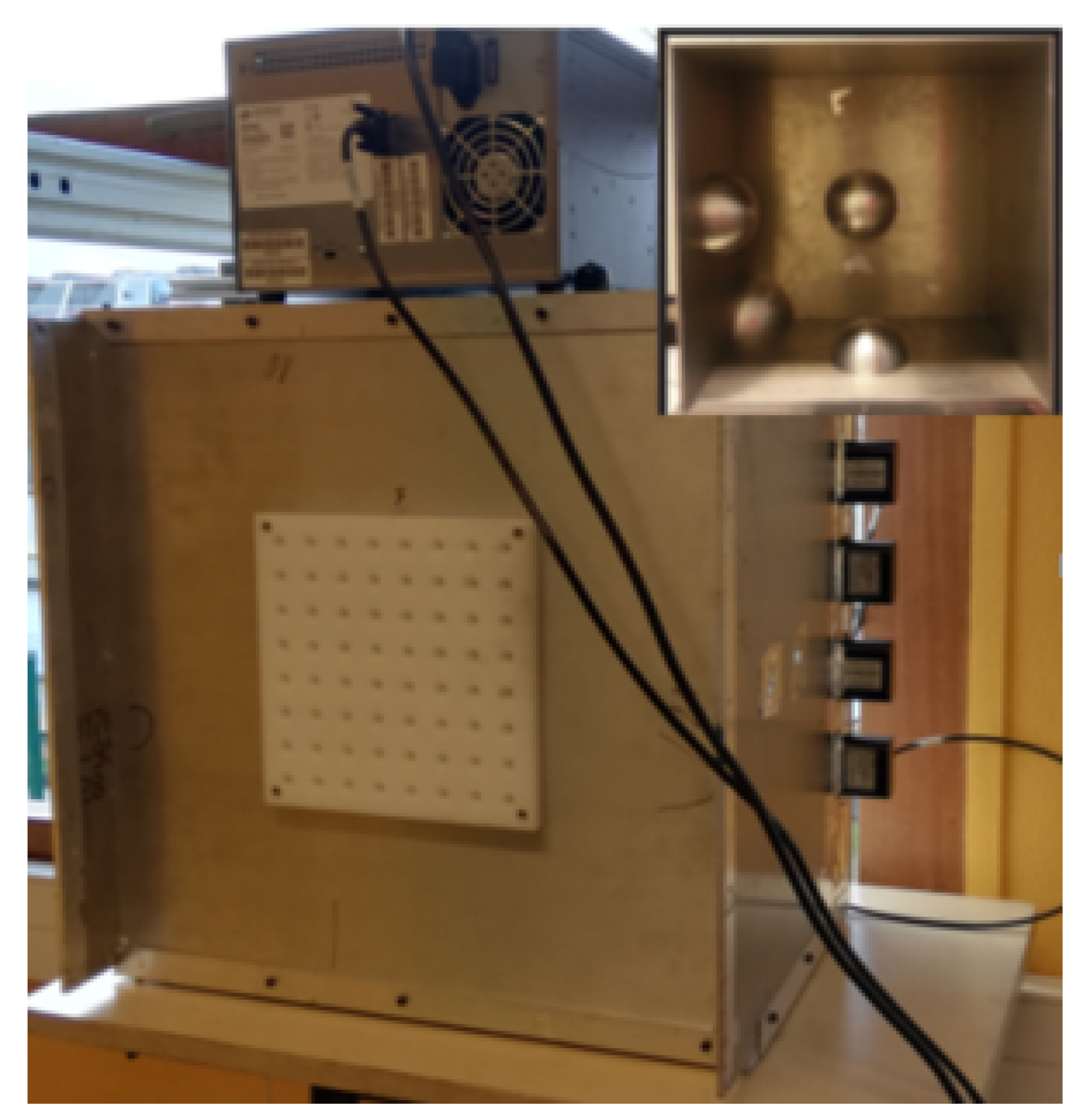
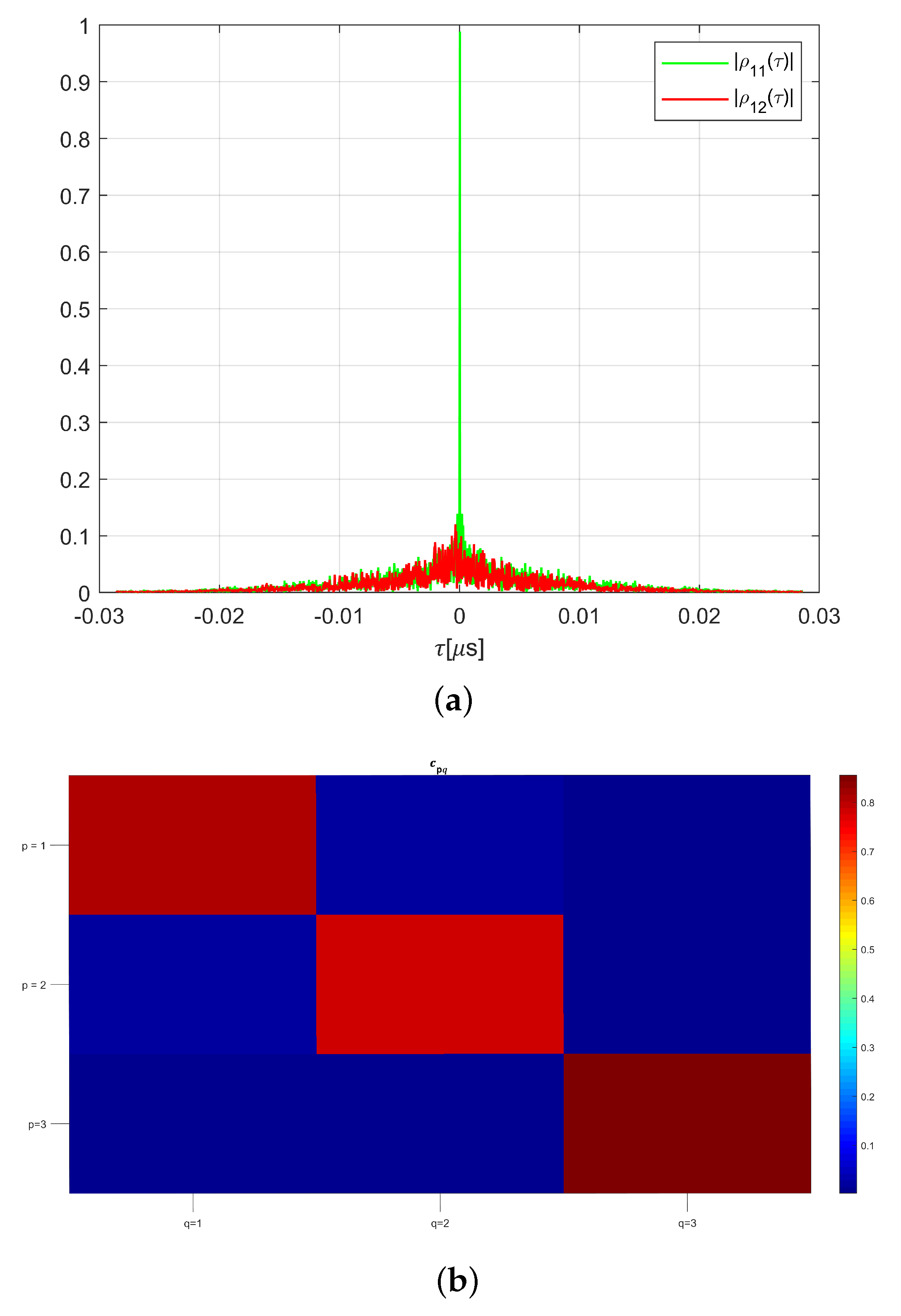
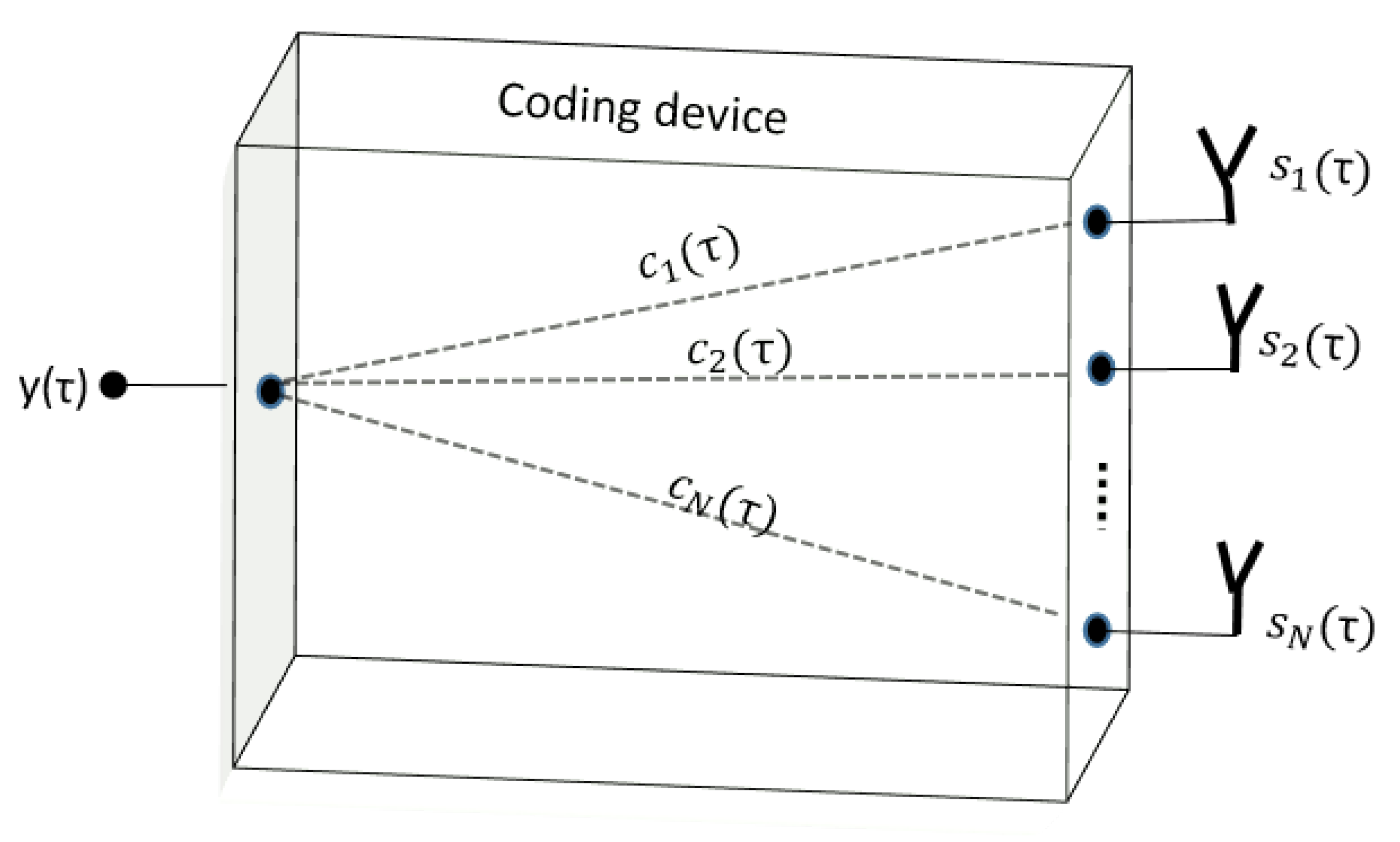
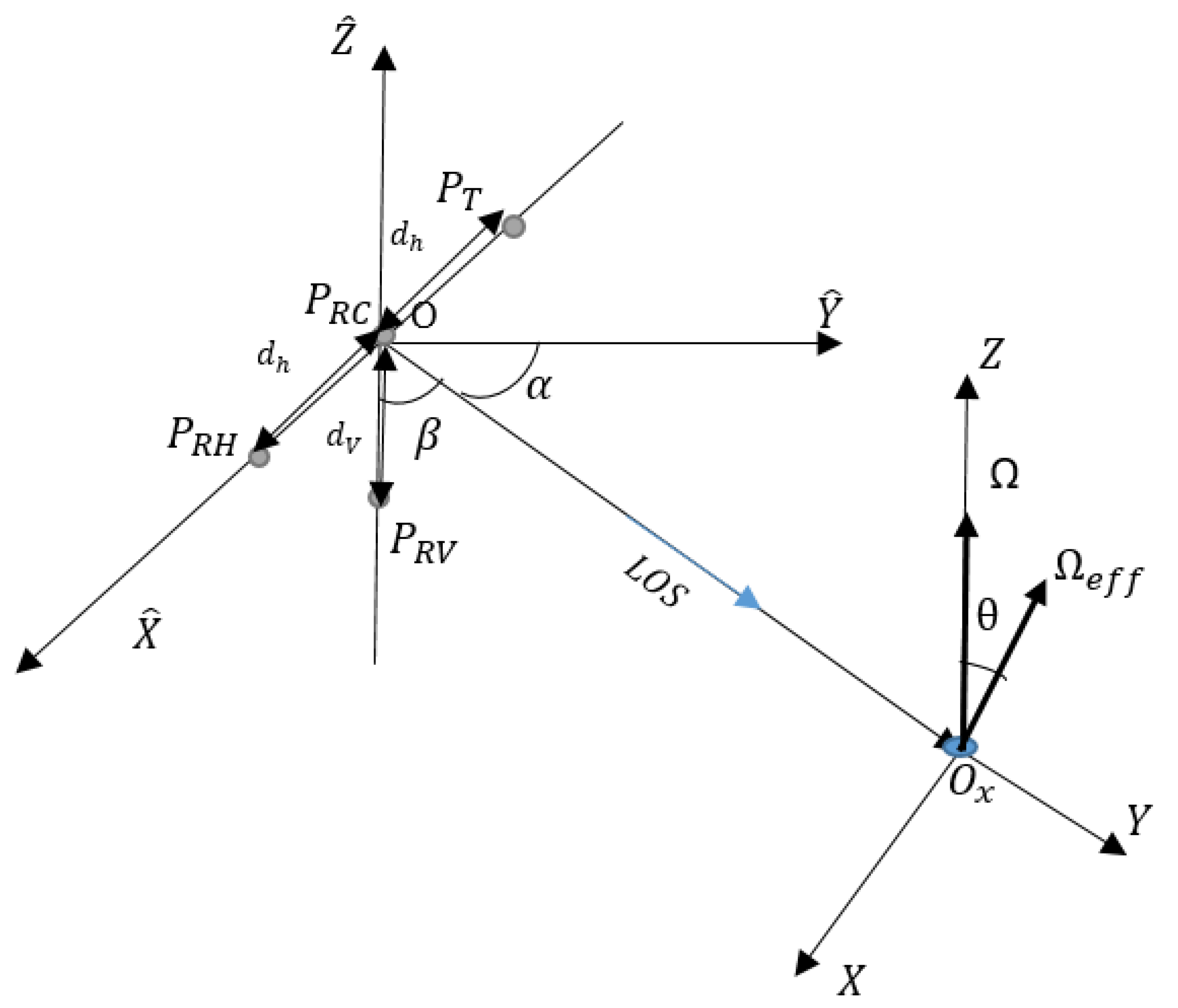

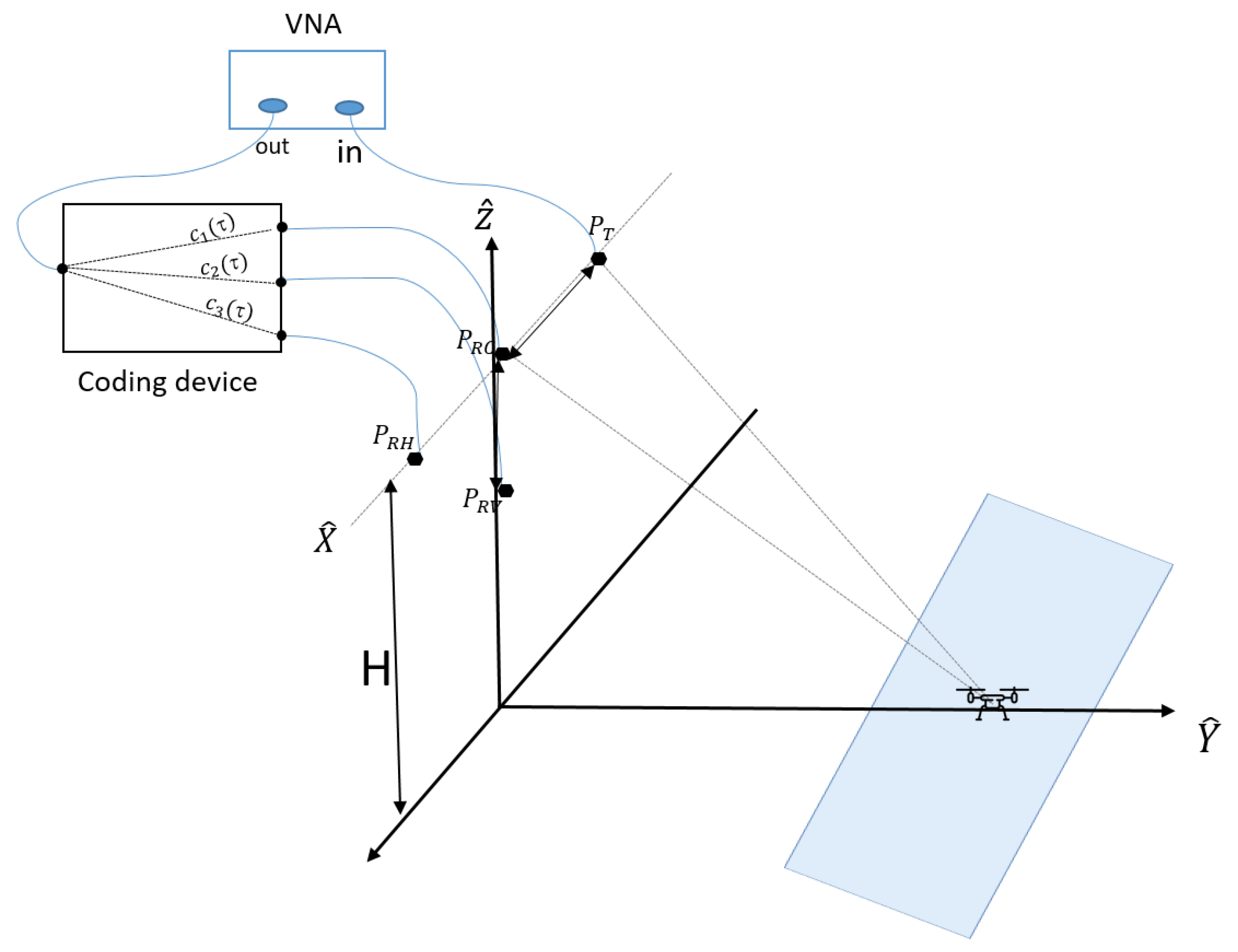
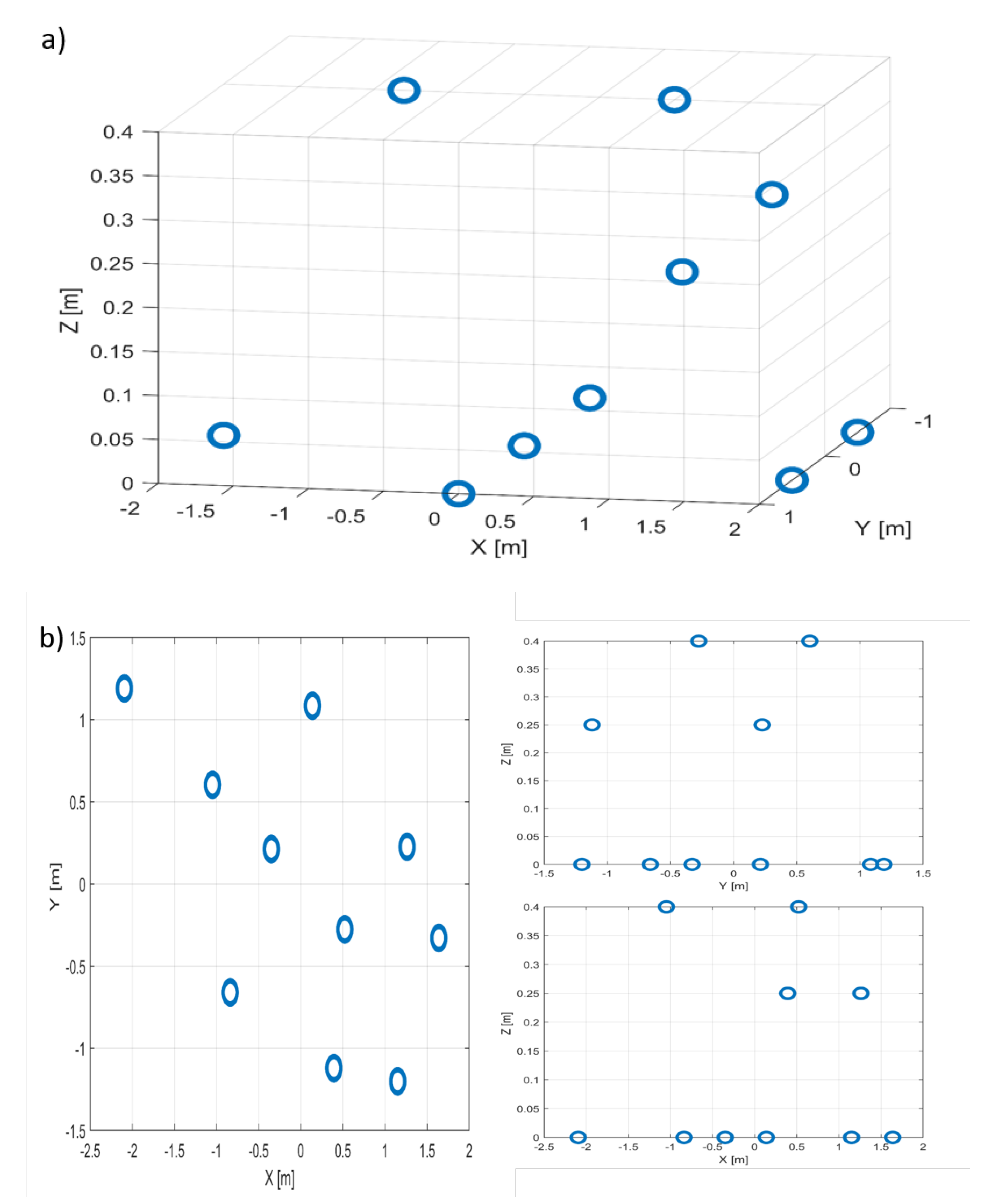
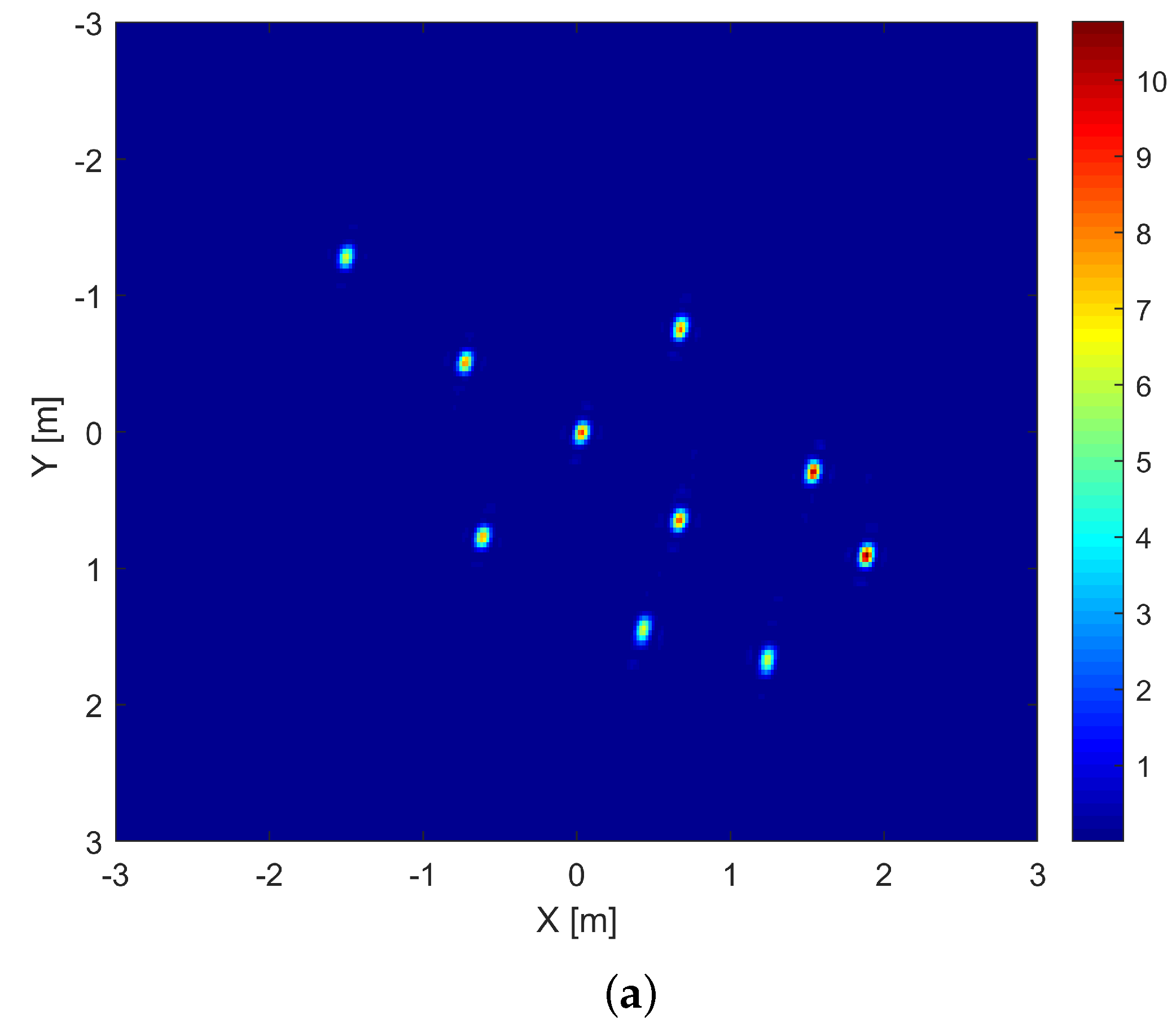
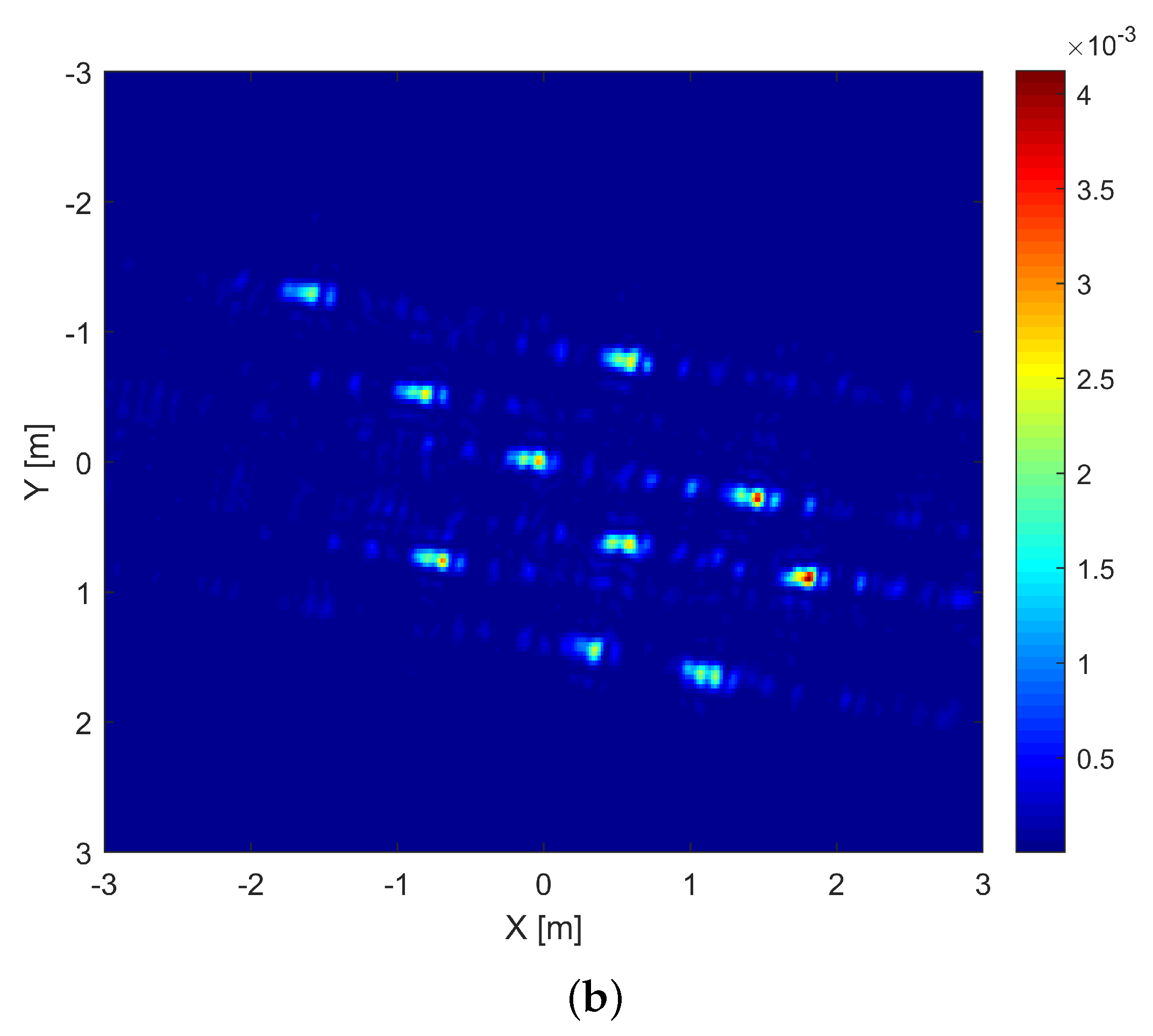
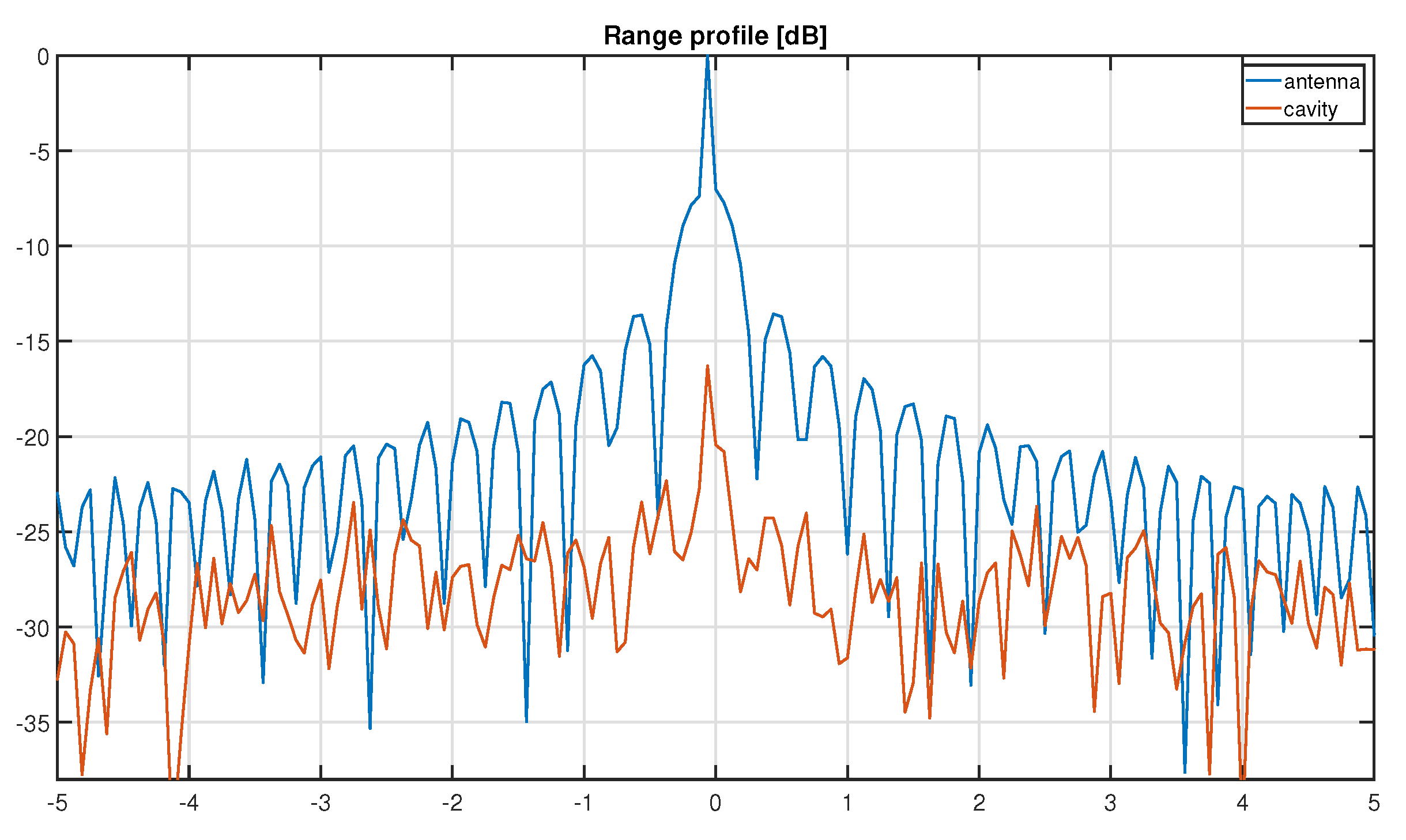
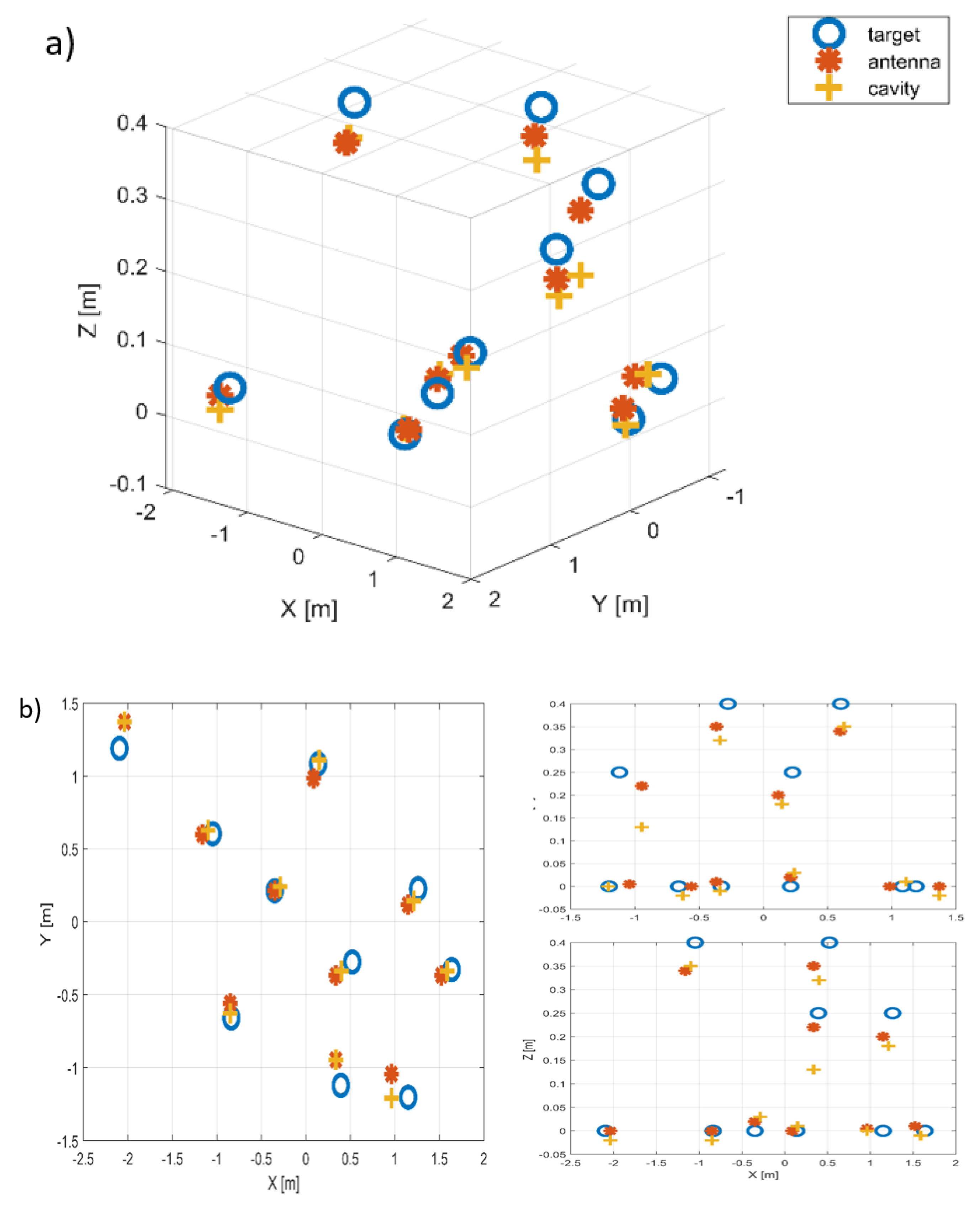
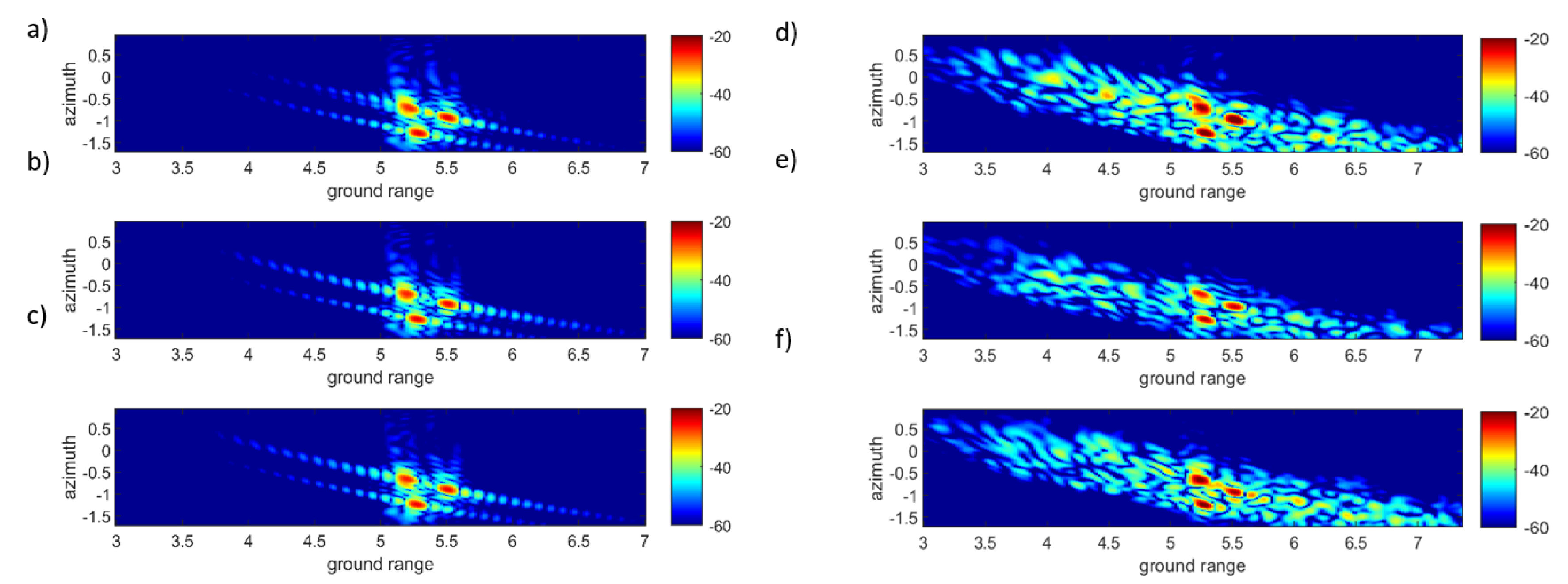
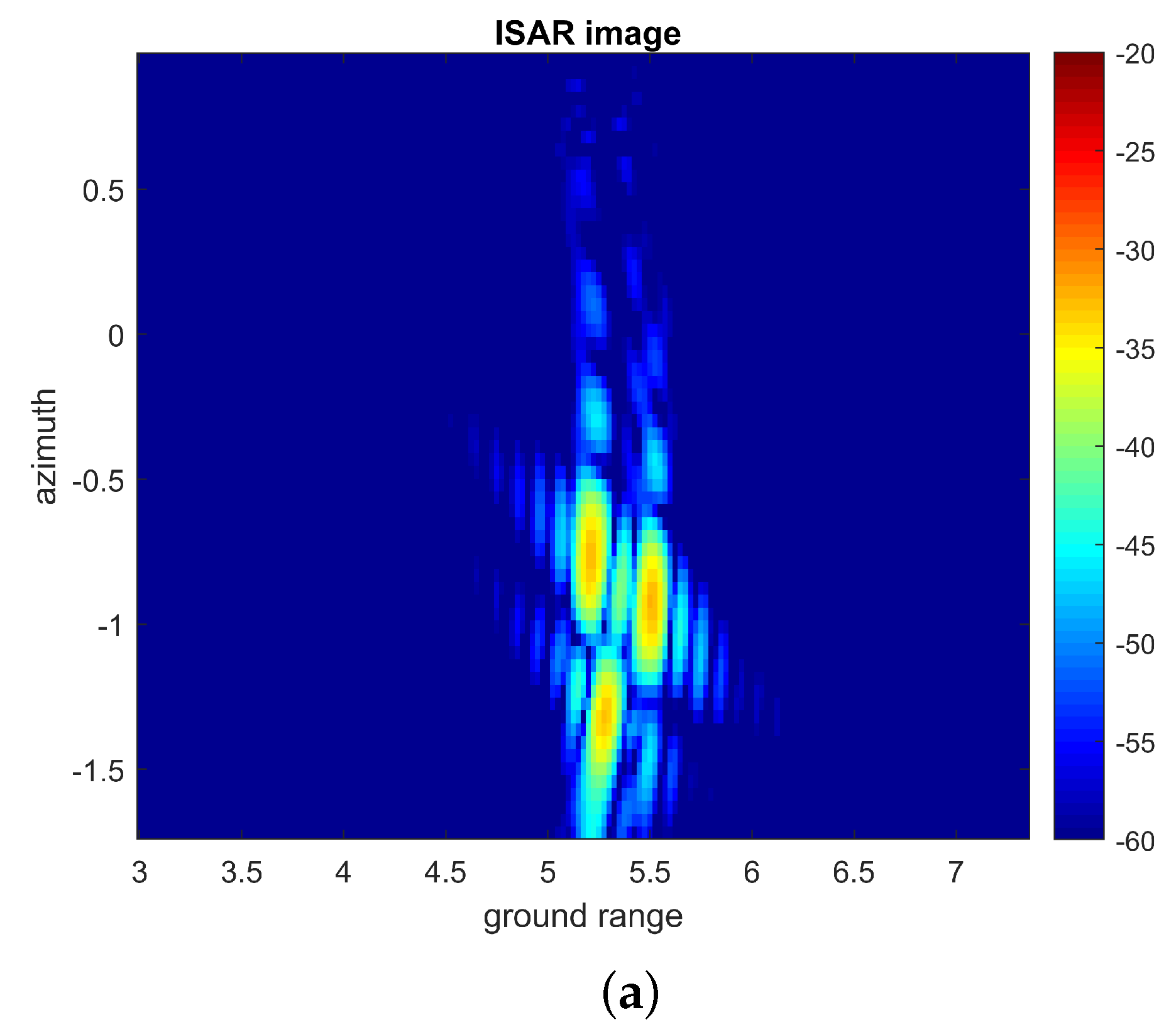
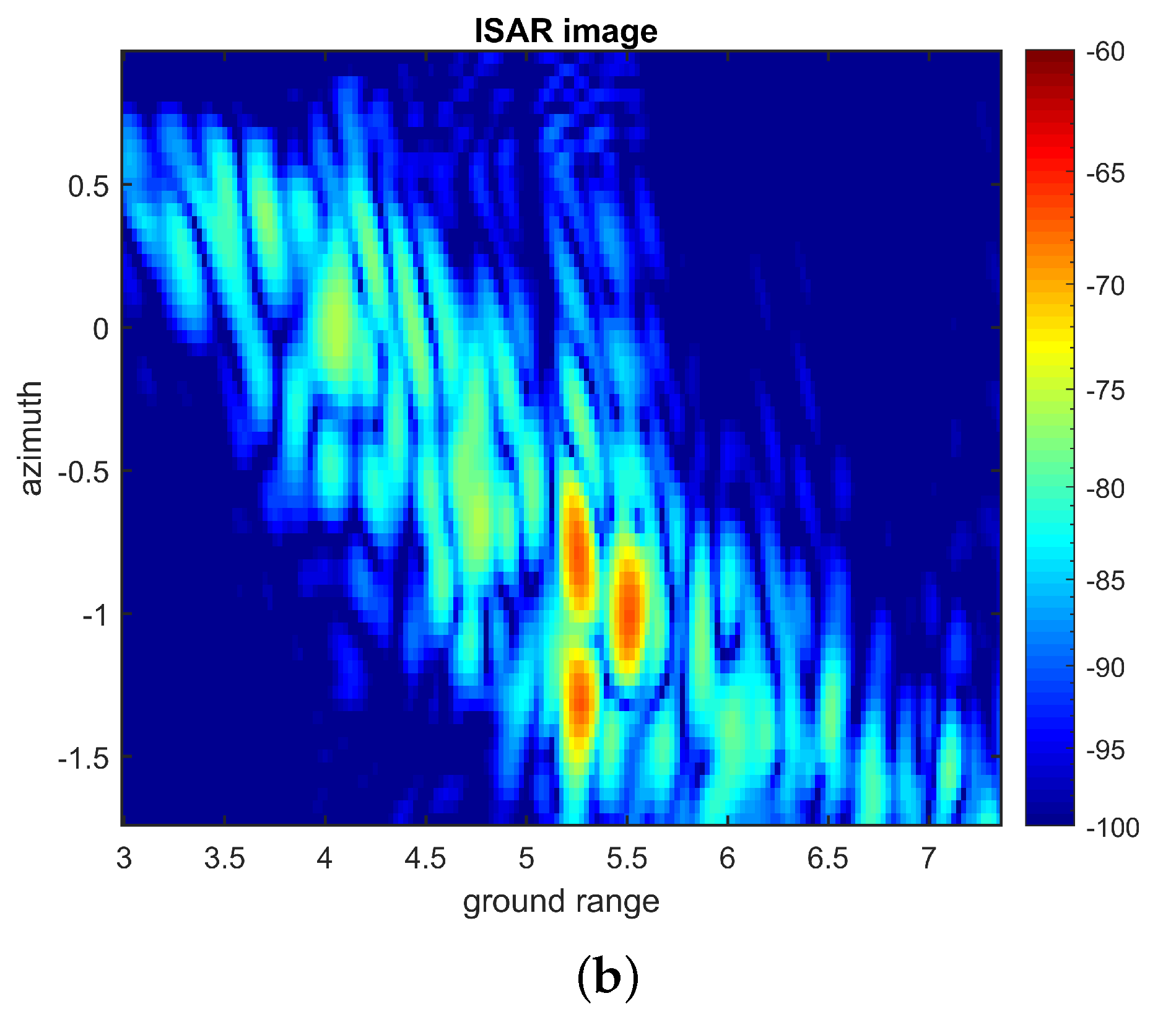
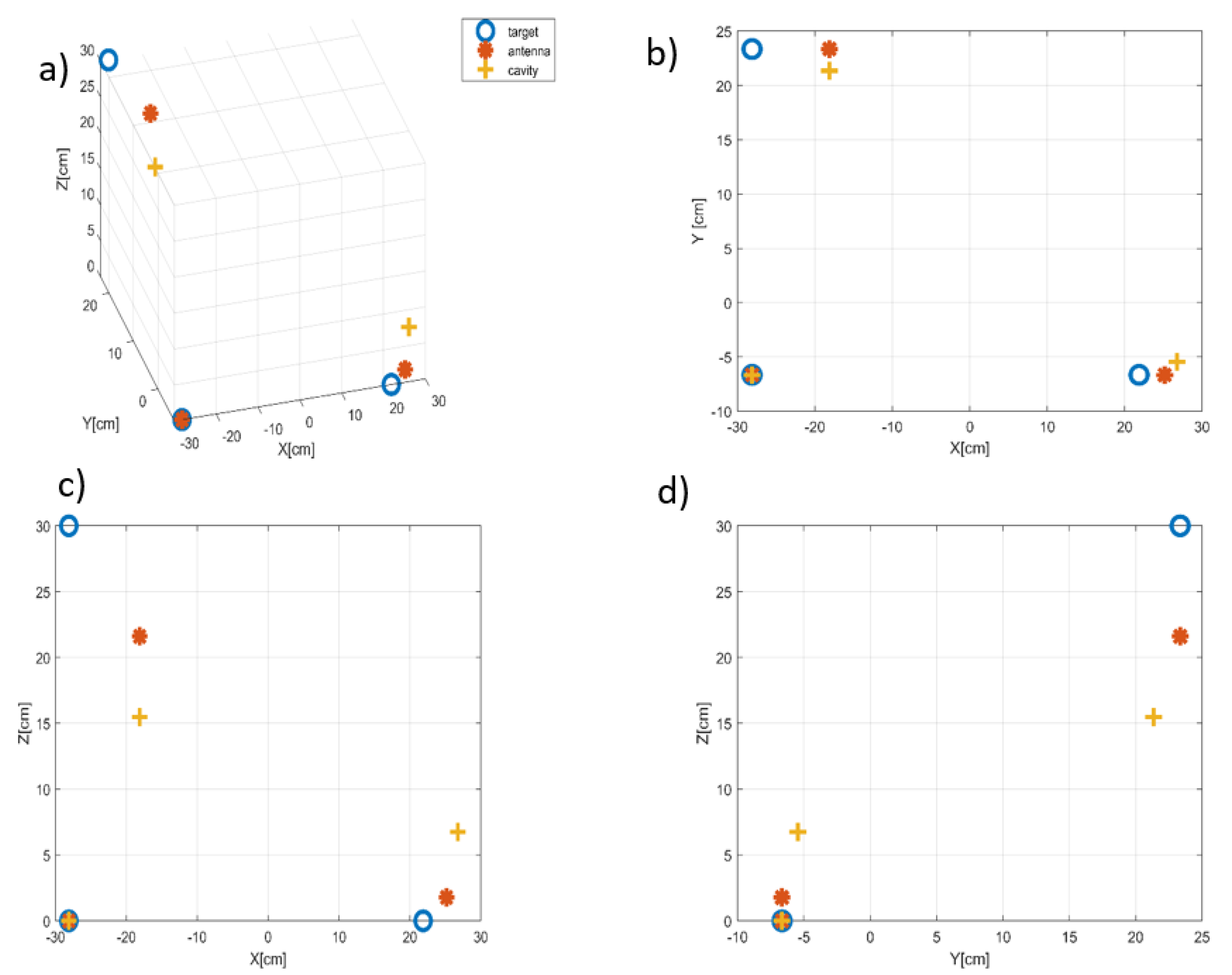
| Parameters | Values |
|---|---|
| Carrier frequency | 6 GHz |
| Signal bandwidth | 2 GHz |
| Baseline () | 30 cm |
| Number of frequency samples | 2001 |
| Number of radar sweeps | 120 |
| PRF | 800 Hz |
| Ground range | 25.5 m |
| Roll/Pitch/Yaw | |
| Radar height | 5 m |
| Trihedral Number | (X, Y, Z) |
|---|---|
| 1 | (0, 0, 0) |
| 2 | (0.5, 0, 0) |
| 3 | (0, 0.3, 0.35) |
| Measurement | Length (cm) | Width (cm) | Height (cm) |
|---|---|---|---|
| True value | 50 | 30 | 35 |
| Multichannel InISAR | 52 | 29 | 21 |
| Single compressed channel | 55 | 28 | 15 |
Publisher’s Note: MDPI stays neutral with regard to jurisdictional claims in published maps and institutional affiliations. |
© 2022 by the authors. Licensee MDPI, Basel, Switzerland. This article is an open access article distributed under the terms and conditions of the Creative Commons Attribution (CC BY) license (https://creativecommons.org/licenses/by/4.0/).
Share and Cite
Lo, M.D.; Davy, M.; Ferro-Famil, L. Low-Complexity 3D InISAR Imaging Using a Compressive Hardware Device and a Single Receiver. Sensors 2022, 22, 5870. https://doi.org/10.3390/s22155870
Lo MD, Davy M, Ferro-Famil L. Low-Complexity 3D InISAR Imaging Using a Compressive Hardware Device and a Single Receiver. Sensors. 2022; 22(15):5870. https://doi.org/10.3390/s22155870
Chicago/Turabian StyleLo, Mor Diama, Matthieu Davy, and Laurent Ferro-Famil. 2022. "Low-Complexity 3D InISAR Imaging Using a Compressive Hardware Device and a Single Receiver" Sensors 22, no. 15: 5870. https://doi.org/10.3390/s22155870
APA StyleLo, M. D., Davy, M., & Ferro-Famil, L. (2022). Low-Complexity 3D InISAR Imaging Using a Compressive Hardware Device and a Single Receiver. Sensors, 22(15), 5870. https://doi.org/10.3390/s22155870





